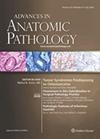Immunohistochemistry of Lung Cancer Biomarkers.
IF 2.6
2区 医学
Q1 PATHOLOGY
引用次数: 0
Abstract
Immunohistochemical (IHC) staining represents a comparatively inexpensive testing method that is attractive as a potential alternative to molecular sequencing methods or fluorescence in situ hybridization for pulmonary biomarker testing. While a variety of IHC tests directed at actionable genetic alterations have been developed and evaluated since the advent of targeted therapy, specific antibody clones for anaplastic lymphoma kinase, ROS-1, and potentially neurotrophic tropmyosin receptor kinase have been the primary antibodies that provide sufficiently robust results to be utilized as either a primary testing or screening method to direct targeted therapy. Antibodies for a variety of other targets such as epidermal growth factor receptors, for example, have lacked sufficient sensitivity and specificity to cover the range of mutations that may occur and are generally not recommended in lieu of molecular testing with the exception of limited resource settings. IHC is also used as a predictive marker for response to immunotherapy through evaluation of programmed death ligand 1 expression. In addition, multiple antibody-drug conjugates (ADCs) are under investigation, designed to deliver drugs directly to tumor cells through binding to specific target antigens. Some ADCs have already received accelerated FDA approval, and IHC was incorporated in many clinical trials evaluating ADC efficacy. As such, it is anticipated that ADCs may have a companion diagnostic IHC to guide patient selection.肺癌生物标志物的免疫组化。
免疫组化(IHC)染色是一种相对廉价的检测方法,可替代分子测序法或荧光原位杂交法进行肺部生物标记物检测,因此很有吸引力。虽然自靶向治疗出现以来,针对可操作基因改变的各种 IHC 检测方法已被开发和评估,但针对无性淋巴瘤激酶、ROS-1 和潜在的神经营养性肌球蛋白受体激酶的特异性抗体克隆一直是主要的抗体,它们能提供足够可靠的结果,可用作指导靶向治疗的主要检测或筛选方法。针对表皮生长因子受体等其他靶点的抗体缺乏足够的灵敏度和特异性,无法覆盖可能发生的突变范围,因此除资源有限的情况外,一般不建议用其代替分子检测。通过评估程序性死亡配体 1 的表达,IHC 也被用作免疫疗法反应的预测标志物。此外,多种抗体-药物共轭物(ADCs)也在研究之中,旨在通过与特定靶抗原结合,将药物直接输送到肿瘤细胞。一些 ADC 已获得 FDA 加速批准,IHC 已被纳入许多评估 ADC 疗效的临床试验中。因此,预计 ADC 可能会有辅助诊断 IHC 来指导患者的选择。
本文章由计算机程序翻译,如有差异,请以英文原文为准。
求助全文
约1分钟内获得全文
求助全文
来源期刊
CiteScore
10.30
自引率
3.00%
发文量
88
审稿时长
>12 weeks
期刊介绍:
Advances in Anatomic Pathology provides targeted coverage of the key developments in anatomic and surgical pathology. It covers subjects ranging from basic morphology to the most advanced molecular biology techniques. The journal selects and efficiently communicates the most important information from recent world literature and offers invaluable assistance in managing the increasing flow of information in pathology.

 求助内容:
求助内容: 应助结果提醒方式:
应助结果提醒方式:


